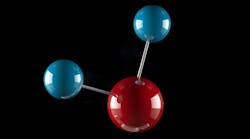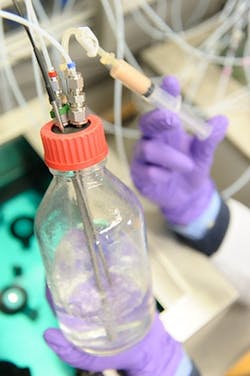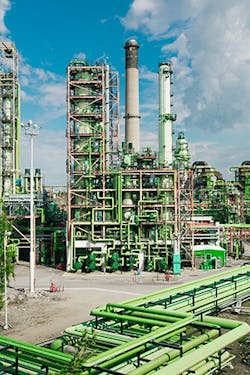The quest to turn carbon dioxide into a valuable raw material has spurred significant efforts for some time. Attention certainly isn’t flagging as ongoing activities of some chemical companies and research groups attest. For instance, Evonik, Clariant and Neste all are investing in technologies with that aim. At the same time, research breakthroughs are giving glimpses into how the next generation of catalysts to convert the greenhouse gas might look and work.
Evonik, Essen, Germany, has joined forces with specialty chemicals company Beiersdorf, Hamburg, Germany, in a joint research project to use CO2 as a raw material in the manufacture of personal care products including skin moisturizers and sun creams.
The aim is to apply Evonik’s artificial photosynthesis technology — electricity from solar energy together with bacteria — to produce raw materials for such products and then test them in different applications (Figure 1).
The project has attracted €1 million ($1.18 million) in funding from Germany’s Federal Ministry of Education and Research (BMBF).
“This work is taking place on a laboratory scale and in parallel with the Rheticus II project being carried out jointly by Evonik and Siemens Energy. Rheticus II is focused on industrial scale-up of artificial photosynthesis,” says Thomas Haas, who is responsible for the project within Evonik’s strategic research department Creavis.
With €3.5 million ($4.13 million) in funding from the BMBF, Evonik and Siemens Energy are constructing a test facility in Marl, Germany, that comprises an electrolyzer and a bioreactor.
Figure 1. Research project focuses on using artificial photosynthesis technology to make raw materials for personal care products. Source: Evonik.
“The official starting date for joint test operation of the electrolyzer and bioreactor is end-September 2020. The composition of the synthetic gas and the interaction of electrolysis and fermentation will be tested and optimized in the coming weeks,” he adds.
For the moment, the focus is on the design/dimensioning of the interfaces between the electrolyzer and bioreactor.
“As soon as these have been optimized, it will be possible to ensure stable and reliable operation of the individual modules and, ultimately, the entire platform. After that, the impact of load changes caused by fluctuations in power supply based on renewable energy during operation will be investigated,” notes Haas.
The first target molecules are butanol and hexanol; work continues on fine-tuning process conditions to investigate fully their significant effect on production of the alcohols.
“That said, the Rheticus project is about developing a platform facility. In other words, it is conceivable that different organisms could be used in the future for other target products. The selection of the organisms and the process conditions are the main variables for the different target products this platform could be used for. The key features of this technology are flexibility and modularity,” he stresses.
Rheticus II finishes towards the end of 2021 and, if successful, Haas believes the first commercial facilities could be designed and built to manufacture specialty chemicals from CO2 and electricity a few years after that.
Compact Technology
In July, Clariant, Muttenz, Switzerland, joined forces with Ineratec, Karlsruhe, Germany, to develop and commercialize novel technologies to produce renewable fuels and chemicals.
Ineratec’s technology is based on modular reactors with micro-structured cores that provide a large surface area for heat and mass transfer. Highly exothermic reactions, such as methanol synthesis and CO2 hydrogenation, achieve high conversions per reactor pass in compact container-sized plants, claims the company.
Clariant brings three of its specialist catalysts to the table: HyProGen R-70, which produces renewable syngas via reverse water-gas-shift — an essential step in the conversion of green hydrogen and CO2 to green fuels; its signature methanol catalyst MegaMax; and Meth 134, which supports the efficient hydrogenation of CO2 to methane.
“One focus is on syngas production from CO2 and hydrogen via reverse water-gas-shift. A second is the production of renewable methanol directly from CO2 and green hydrogen. Methanol can serve as fuel additive or as raw material for other chemical products. Clariant’s methanation catalyst has been proven as catalyst of choice for Ineratec methanation technology,” says Ineratec cofounder and managing director Tim Boeltken.
Strategic partnerships between catalyst and reactor specialists are essential for the technology to develop, he believes. “A perfect fit between the highly active and selective catalysts and the innovative micro-structured reactor technology is crucial for efficient and robust power-to-X systems to enable affordable renewable fuels and chemicals for everyone.”
For its part, Clariant will track the performance and operational lifetime of its catalysts in Ineratec’s modular reactors.
“As part of our collaboration, Clariant provides access to existing as well as next-generation materials and catalysts from Clariant’s power-to-X catalyst portfolio as they are available and provides technical support to Ineratec regarding specific operational challenges,” notes Thomas Cotter, business development manager, Clariant Catalysts.
“Generally speaking, the modular reactor concept provides greater heat control and homogeneity of process parameters to the catalysts, which enable them to perform optimally under given conditions. Where we can identify clear mutual opportunities to improve the combination of reactor and catalyst, we consider entering joint catalyst development in order to address larger markets,” he explains.
Currently, the Ineratec system’s CO2 recycling capacity ranges from 1,000–10,000 mt/y, with the higher capacities reached by linking several plant modules.
“We are continuously improving and adapting the reactor technology. The current focus is the further scale-up of the reactor modules while maintaining the already achieved reactor properties,” adds Boeltken.
High-Temperature Electrolysis
Meanwhile, Neste, Espoo, Finland, has acquired a minority stake in high-temperature electrolysis technology specialist Sunfire, Dresden, Germany, whose patented technology allows production of renewable hydrogen as well as direct conversion of water and CO2 into raw materials for petrochemicals.
Sunfire’s key technology is its PowerCore solid-oxide cell stack that can convert both electrical energy into chemical energy, and liquid and gaseous fuels based on hydrocarbons, such as natural gas and liquefied petroleum gas, into electricity and heat.
“As part of Neste's strategy, we are developing business platforms for new growth. Renewable hydrogen and power-to-X is one of these platforms. Power-to-X technologies enable the utilization of CO2 as raw material for synthetic fuels, such as aviation fuel, and chemicals. We see Sunfire’s high-temperature electrolysis technology as a promising technology for power-to-X solutions and so decided to invest in the company,” says Lars Peter Lindfors, senior vice president, innovation at Neste.
Both companies now are working together to demonstrate the production of renewable hydrogen at Neste’s Porvoo, Finland, refinery using Sunfire’s high-temperature electrolyzer (Figure 2).
Figure 2. Trials of high-temperature unit are taking place at refinery in Porvoo, Finland. Source: Neste.
In a separate development, SunFire has joined Norsk e-Fuel, a new consortium headquartered in Oslo, Norway, focused on industrializing power-to-liquid technology in Norway for the European market.
Its state-of-the-art project at Herøya, Norway, will allow conversion of the country’s extensive renewable electricity resources into renewable fuels.
The first plant, with a production capacity of 10 million l/y of renewable fuel, should begin operation in 2023. The plan is to boost capacity ten-fold to 100 million l/y before 2026. This scaled-up plant then will serve as a blueprint for a nationwide rollout of the technology.
Meanwhile, in March, Finland’s Technical Research Center (VTT), Espoo, and business partners launched the €5-million ($5.9-million) bio-energy-based CO2 for polyols and fuels (BECCU) project. It will produce olefins through reverse water-gas-shift and Fischer-Tropsch (FT) reaction steps. The olefins will undergo conversion to epoxides through oxidation reactions by peroxides, with the epoxides then polymerized together with CO2 to obtain polyols. Hydrogen for the process will come via renewable electricity or from industrial byproduct sources. The team will test each stage of the process using VTT’s pilot and laboratory equipment and assess the techno-economic requirements for the entire lifecycle. It also will compare the concept with other power-to-X processes that produce chemicals and fuels from CO2 and hydrogen.
“Many tasks have progressed as planned and capture tests for CO2 begin in September. Also, the only part now needed for the FT-synthesis lab device is the recirculation compressor. The technical economic assessment and lifecycle analysis work is progressing well,” notes VTT senior scientist Janne Kärki.
“If we can show in small-scale that the concept is feasible, the aim then is, of course, to scale it up,” he adds.
Part of the project focuses on developing a multipurpose synthesis unit (MOBSU) for CO or CO2 upgrading to energy carriers, fuels and chemicals that could be transported to sites where CO2 emissions and energy are available. The capacity of the first MOBSU is expected to be 3–5 l/d for liquid hydrocarbons and 6–9 l/d for solids such as waxes.
“Current funding for BECCU runs for two years and we will be looking for new opportunities along the way for continuation, hopefully more on the demonstration side with interested companies,” concludes Kärki.
Coming Catalysts
A research collaboration between the U.S. Department of Energy’s Argonne National Laboratory, Lemont, Ill., and Northern Illinois University, DeKalb, Ill., has discovered a new electrocatalyst that converts CO2 and water into ethanol.
The catalyst, which consists of atomically dispersed copper on a carbon powder support, breaks down CO2 and water molecules and selectively reassembles them into ethanol under an external electric field.
“Tested under ambient temperature and pressure, the catalyst maintained 90% selectivity during the 16-h durability test and showed no significant change in current density,” notes Di-Jia Liu, chemist and principal investigator in the catalysis and energy conversion group at Argonne.
“We found that the metal dispersion in the catalyst is very important in controlling the selectivity. When the copper cluster size becomes bigger, the selectivity toward conversion to ethanol drops significantly. This probably explains why other studies did not report >90% selectivity,” he adds.
The study, reported in recent issue of Nature Energy, used a half cell and solely focused on the electrochemical reduction of CO2 to ethanol at the cathode.
“To make a large-scale industrial production, the catalyst needs to be integrated into an electrolyzer. Challenges here include how to produce high current density at low voltage through extended period of operation — so more engineering research on electrode design — together with mass-charge transport, product separation, etc., [is needed],” explains Liu.
The work already has attracted industrial interest, although details remain guarded.
Meanwhile, researchers at Heriot-Watt University, Edinburgh, Scotland, and Murdoch University, Murdoch, Australia, have found a new way to fabricate a complex nanostructured photocatalyst for solar fuels.
The resulting raspberry-like microspheres have a core-shell nanostructure that can capture CO2 and convert it into methane.
“The discovery of this project has demonstrated the importance of the photocatalytic active site on the photocatalyst,” notes Jeannie Z.Y. Tan, a research associate in the Research Centre for Carbon Solutions (RCCS) at Herriot-Watt.
Figure 3. Test sheet is 20 cm2 but researchers say scale-up is easy. Source: Sarah Collins, Cambridge University.
The initial study, described in a recent issue of Chemistry & Sustainability, used a 2-cm3 photoreactor that gave conversion rates of 0.2 µmol/g of catalyst in one hour.
“The aim of the research is practical application and commercialization. To achieve this, both the cost and efficiency need to be considered,” stresses Tan.
“In the published paper, the observation on the formation of photocatalytic active site and the role it played provides important information for future investigation. We will continue to explore this characteristic and extend the work to other photocatalysts,” she adds.
Scale-up challenges include actual CO2 uptake by the catalyst, product selectivity, product separation, deactivation of catalyst and reactor design, Tan says.
The RCCS also is pursuing other CO2 utilization projects, including generation of cyclic carbonate or polycarbonates from epoxides, and photoelectrocatalysis of CO2 to formic acid/formate.
Finally, researchers at the University of Cambridge, Cambridge, England, have developed a standalone device that uses a cobalt-based photocatalyst to convert sunlight, CO2 and water into oxygen and formic acid, a storable fuel that either can be used directly or converted into hydrogen. The device doesn’t require any additional components or electricity.
The photocatalysts are embedded in 20-cm2 test sheets made of readily available semiconductor powders (Figure 3).
“We were surprised how well it worked in terms of its selectivity — it produced almost no byproducts,” says Qian Wang of Cambridge’s department of chemistry. “Sometimes things don’t work as well as you expected, but this was a rare case where it actually worked better,” she adds.
The researchers now are experimenting with a range of different catalysts to improve both stability and efficiency of the sheets.
Seán Ottewell is Chemical Processing's editor at large. You can email him at [email protected].






